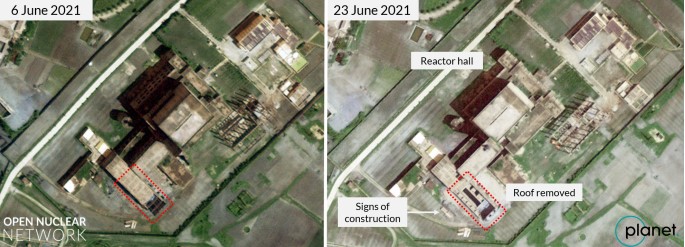The views expressed in this post are those of the author and not necessarily those of Open Nuclear Network or any other agency, institution or partner.
Analysis of satellite imagery from June 2021 revealed new activity at the abandoned 50 MWe reactor at Yongbyon, Democratic People's Republic of Korea.
Planet Labs high resolution imagery from 23 June shows that approximately half of the rooftop (~40x20 meters) was removed from a building adjacent to the main facility that houses the 50 MWe reactor. Construction material was placed next to the building. The development happened sometime between June 6 and June 23.
In January 2020, 38 North reported that "a number of unusual activities" had occurred around this site in 2018 and 2019, including the razing of a small building in late 2019, but also noted that, "while the purpose is unknown, these activities are unlikely related to renewed construction." [1] The scale of the new activity in 2021 appears larger than that previously observed by 38 North, possibly indicating more extensive modification, repair or demolition activity at this building.
At the time of this writing, the objective of the new activity remains unknown. ONN will continue to monitor the developments on the site.

Recent construction at the 50 MWe reactor site and Yongbyon, June 2021. Image © 2021 Planet Labs Inc. All Rights Reserved. Reprinted by permission
Background Information on 50 MWe Reactor
The DPRK is believed to have begun construction of the 50 MWe reactor in the Yongbyon Nuclear Scientific Research Center sometime in the mid to late 1980s. [2] Construction was later suspended under the terms of the 1994 Agreed Framework. [3] Under the Agreed Framework, the International Atomic Energy Agency (IAEA) visited the Yongbyon site and confirmed that the facilities subject to the freeze (which included the 50 MWe reactor) were not in operation and that construction work had stopped. [4] During his visit to the DPRK in 2010, Siegfried Hecker was informed by the DPRK that the facility had been abandoned. [5]
In his latest report to the General Conference, dated 1 September 2020, the IAEA Director General no longer referred to the 50 MWe reactor, stating that, "No significant construction activities were observed in or near the Kuryong river in the vicinity of the LWR and 5MW(e) reactor." [6] [7]
[1] Minor Modifications at the Abandoned 50 MWe Reactor at Yongbyon, 38North, 10 January 2020, available at: https://www.38north.org/2020/01/yongbyon011020/
[2] Fact Sheet on DPRK Nuclear Safeguards, IAEA, available at: https://www.iaea.org/newscenter/focus/dprk/fact-sheet-on-dprk-nuclear-safeguards
[3] IAEA and North Korea: The Verification Challenge, IAEA, available at: https://www.iaea.org/newscenter/focus/dprk/iaea-and-north-korea-the-verificaton-challenge
[4] Implementation of the Agreement between the Agency and the Democratic People's Republic of Korea for the Application of Safeguards in Connection with the Treaty on the Non-Proliferation of Nuclear Weapons (INFCIRC/403): Report by the Director General to the General Conference, GC(39)/18, 17 August 1995, available at: https://www.iaea.org/sites/default/files/gc/gc39-18_en.pdf
[5] Siegfried S. Hecker, A Return Trip to North Korea's Yongbyon Nuclear Complex, NAPSNet Special Reports, 22 November 2010, available at: https://nautilus.org/napsnet/napsnet-special-reports/a-return-trip-to-north-koreas-yongbyon-nuclear-complex/
[6] Report by the IAEA Director General, Application of Safeguards in the Democratic People's Republic of Korea, GOV2020/42-GC(64)/18, 1 September 2020.
[7] LWR and 5 MWe reactors are also located at the Yongbyon Nuclear Scientific Research Center, not far from the 50 MWe reactor.
